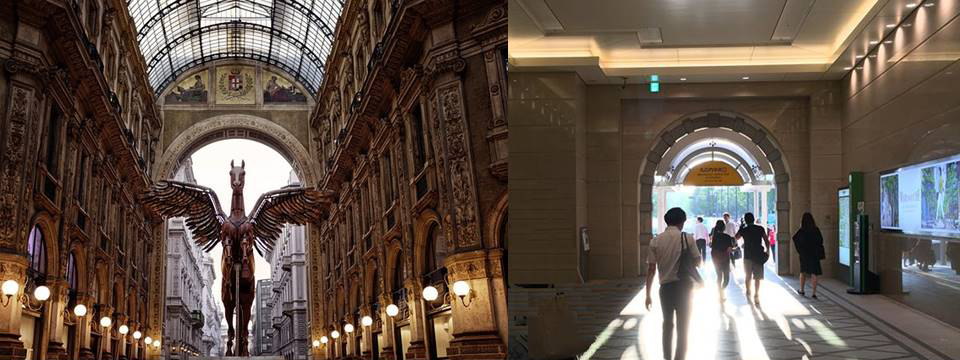(Photo: City Centers / Milano: IgorSaveliev / Tokyo: Toshl Honda / Retouched by Vosot Ikeida)
< Profiles of speakers >
◆ Marco Crepaldi : A young socio-psychologist in Milan, Italy. Founded the web site “Hikikomori Italia” to respond to the increase of hikikomori in Italy, presiding liaison meetings of about 170 families. Refer to his article “What hikikomori is and what Isn’t” which was translated also in Japanese and raised big reactions.
◆ Vosot Ikeida : A middle-aged hikikomori in Tokyo, Japan. Has been a hikikomori intermittently for over 30 years. Refer to his career “Hikikomori Horoki (Odyssey of Hikikomori)“(Japanese). What he speaks out here is his personal opinion and nothing to represent the Hikikomori News.
◆
(Continued from Round 2)
Marco:
I’m very curious to know what kind of activities you have in Japan to deal with the increase of hikikomoris, whether publicly or privately.
I have heard about a city called Fujisato where all the hikikomori have come back to social life. Is that true?
Vosot:
Fujisato is a very countryside small town in northern Japan. In winter, it is covered with heavy snow. We can say the climate is likely to create hikikomoris. The total population is about 3500, the one from 18 to 55 years old is 1293, and 113 among them were said to be hikikomoris. It is true Fujisato has been reported to be a successful case to decrease the number of hikikomoris dramatically, but it is not all of them that’s gone back to social life. I hear still 25 persons remain as hikikomoris.
Marco:
What kind of method did they use in Fujisato, to let hikikomori go back to the society?
Vosot:
In short, they created “ibashos” for local hikikomoris and then made them participate in the revitalization of the town. In Japan, the declination of population and local industry is a serious problem in a countryside. Fujisato was not exceptional as well. But they tried to utilize the manpower of local hikikomoris for the activation of the town.
Marco:
What does “ibasho” mean?
Vosot:
It literally means “place to be”.
They made a kind of community space where hikikomoris can hobour.
Then hikikomoris spontaneously came out of one’s house and gather at the space, where they can chat, play games, play indoor small sports such like ping pong, having tea or sake, etc.
Nobody forces “to work” there. They can just “be” there. But probably they were glad to make themselves useful by doing some works that were to revitalize their hometown.
Marco:
That sounds nice.
Vosot:
Yes. And, after some months, some of the hikikomoris started to get a job and work socially, they say.
When I went to Italy, I saw cafes in every town, where many local people, mainly male, are gathering, chatting and not working.
According to my impression, it might be similar to an “ibasho”.
Marco:
What do you think the factors were, that led Fujisato to the successful example?
Vosot:
If I am allowed to state my personal opinion, first of all, I am sure the people involved in the project were very enthusiastic and creative. Now that this support for hikikomoris in Fujisato has become so famous and not so many hikikomoris remain any longer inside Fujisato, they are inviting hikikomoris as the object to support from outside of the town, even from Tokyo which is 600 kilometers away. It means, the support was initially created by connecting the local hikikomoris and the revitalization of town at the beginning, but in the end, the support itself has become the revitalization of town or their local industry.
Marco:
That is interesting.
Vosot:
Secondarily, we may be able to say that it was successful just because the town was small. People in Fujisato knew one another since they were born. Potential bonds that they take hikikomoris back into the society were originally there, I suppose.
Moreover, if the town is small, the feeling “I am useful for this town” that hikikomoris hold, will be more likely to become a great motivation for hikikomoris.
In big cities such like Tokyo, the circumstance is more complicated. For example, I am a hikikomori living in a suburb of Tokyo. I was not born in the place I live. I am not intimate with anybody in the town I live in. Then, even if I was told “You can be useful for this town”, I don’t think I get so motivated.
Marco:
It makes a sense.
Is the ibasho method used elsewhere in Japan?
Vosot:
Nowadays the method has been tried everywhere in Japan. Tokyo and its neighboring area have a lot of ibashos. Also, the types of ibasho are so various. There are some people who can be said “Master of making ibasho” as well. Those ibashos run by such individuals seem to be going well.
Mentioning some variation of ibasho. These days I have been involved in “IORI”, meaning “Hermitage”, which is the bimonthly event where over 100 hikikomoris and supporters gather. Though the founders and the core members may have different opinions on this, but I personally think this is a kind of ibasho. It doesn’t have any hard-wear like the one of Fujisato, but it consists only of soft-wear. I mean, it doesn’t have a fixed space like Fujisato, but it is held at different places every two months, and many projects that deal with the hikikomori issue have been born there.
Actually our Hikikomori News is one of them. And, we can say the Hikikomori News itself is a type of variation of ibasho.
…to be continued to Round 4
to the Japanese version of Round 3
——————-


